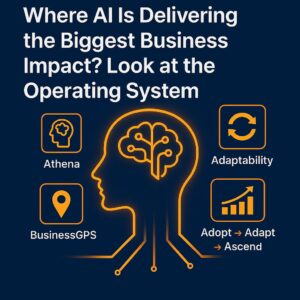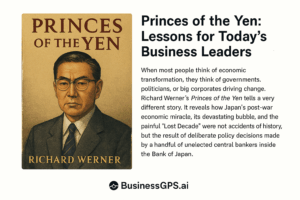
The Digital Leader’s Secret Weapons: YOU Factors and the Value Equation in AI-Driven Transformation
Beyond the Program: Leveraging YOU Factors and the Value Equation for Digital Transformation Success
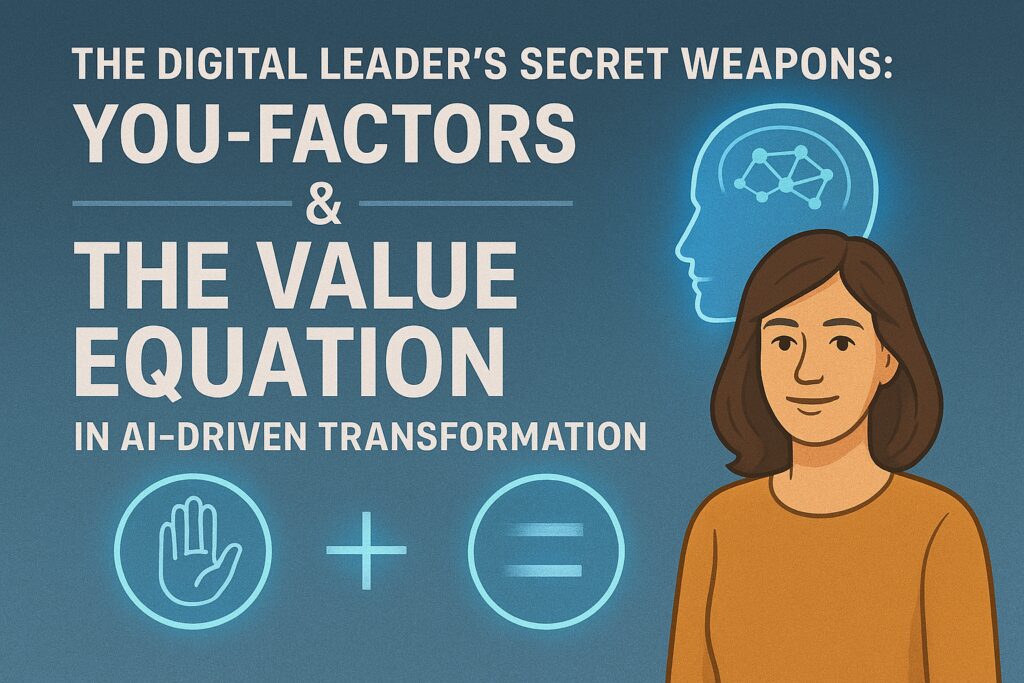
Summary - Why AI adoption and Digital Transformations fail and what YOU can do about it:
After 30 years of advanced technology development and adoption, the foundations are set across the technology stack, including infrastructure, cloud, mobile, compute, know-how, and capability. This puts us at the dawn of a Digital revolution that will see individuals, organizations, and society changed forever.
With this level of shift and compressed time, this will be a 5–10 year cycle. Some leaders will prosper, and many will fail, more so than in the past, as the challenge ahead is even more disruptive. But failure, while often baked in, is not pre-ordained. With the right tools, awareness, and capabilities, this new dawn can present the biggest opportunity of our generation. This is what the YOU Factors and Value Equation is about.
Having undertaken many complex digital transformations and varying conditions and studied many, my conclusion is Digital Transformation Failure is more akin to a “death by a thousand cuts” scenario where a failure is secured by a series of cascading compounding events.
For instance, getting the design finished to start building, getting the build finished to start testing, and getting testing finished to start deployment is the pathway every change must follow. Each Phase brings its own distinct challenges, but they can be made worse by compounding failure from a prior phase. Not completing the build, for example, puts pressure on testing. Firstly, with workarounds, then introducing the functionality when it finally becomes available.
This is all normal. Probably familiar to anybody who has undertaken a digital transformation. It can be managed but can overwhelm easily. However, this is not the core problem. The core problem is WHY these problems are there in the first place?
One significant reason for the high rate of digital transformation failure and value destruction is the fact that 84% of the factors influencing your delivery success are invisible and reside outside the program. This underscores the critical importance of understanding these factors and taking a proactive approach to managing digital transformation.
We call these YOU Factors. They influence YOUR success. YOU must take care of them - by considering them in the context of the Value Equation. YOU cannot offload or abdicate them to a third party. But many are missed or overlooked, or poorly addressed.
A typical program will focus on the Execute E — to build, Delivery Alignment, and Activities columns. See for yourself. You would never produce this Map of YOU factors yourself or your team. It would take too long, too much effort, not enough skills too expensive. By way of example, AI can produce your YOU Map in a matter of minutes. Now with this, you have YOUR MAP of change, and just like any explorer — who has a better Map will have a bigger advantage.
By understanding and applying the Value Equation and cleverly using AI to augment your approach and understanding, you can help surface YOUR and YOUR Organization’s specific challenges and opportunities in AI adoption and Digital Transformation and be one of the few — the 16pc who succeed where 84pc fail.
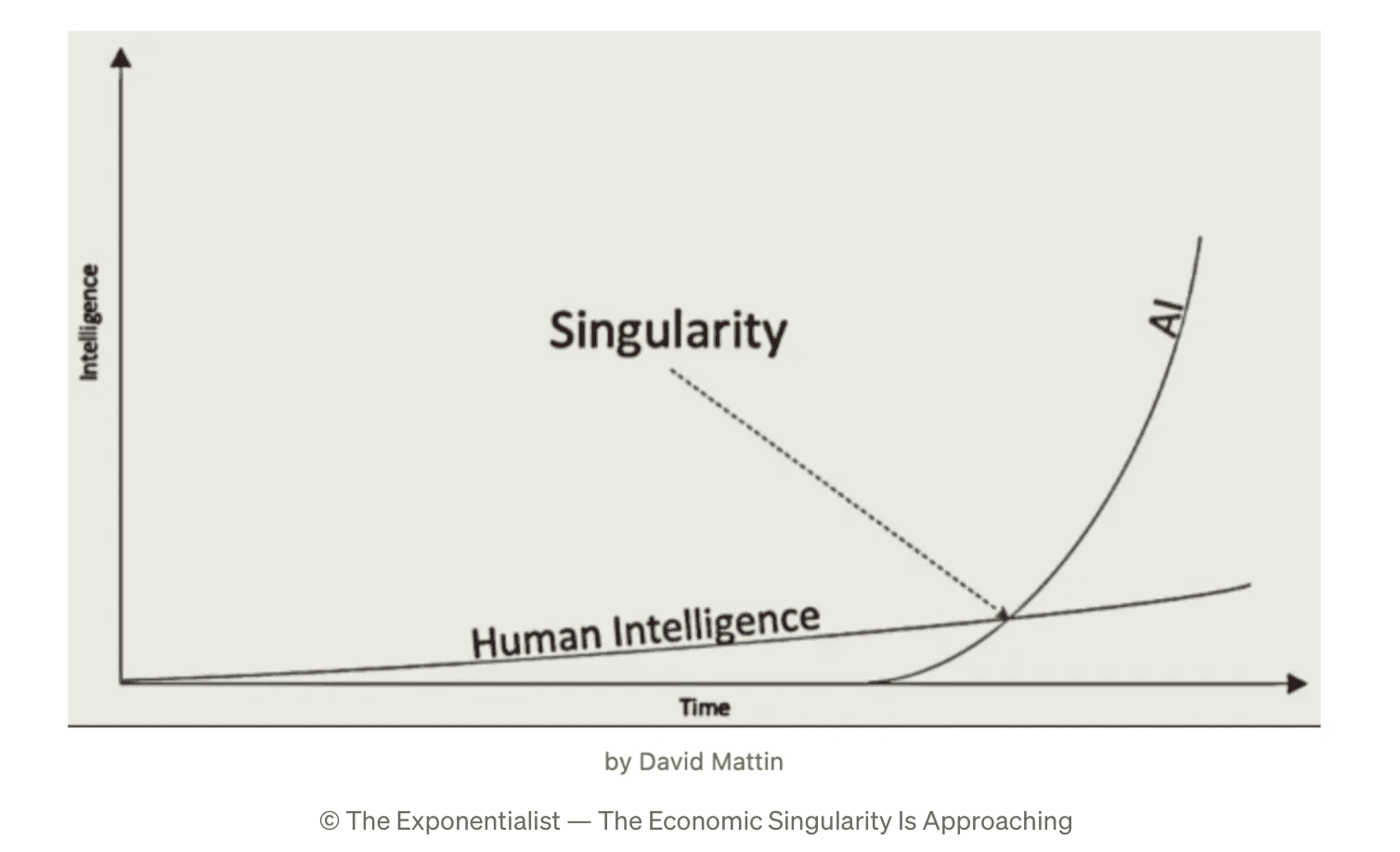
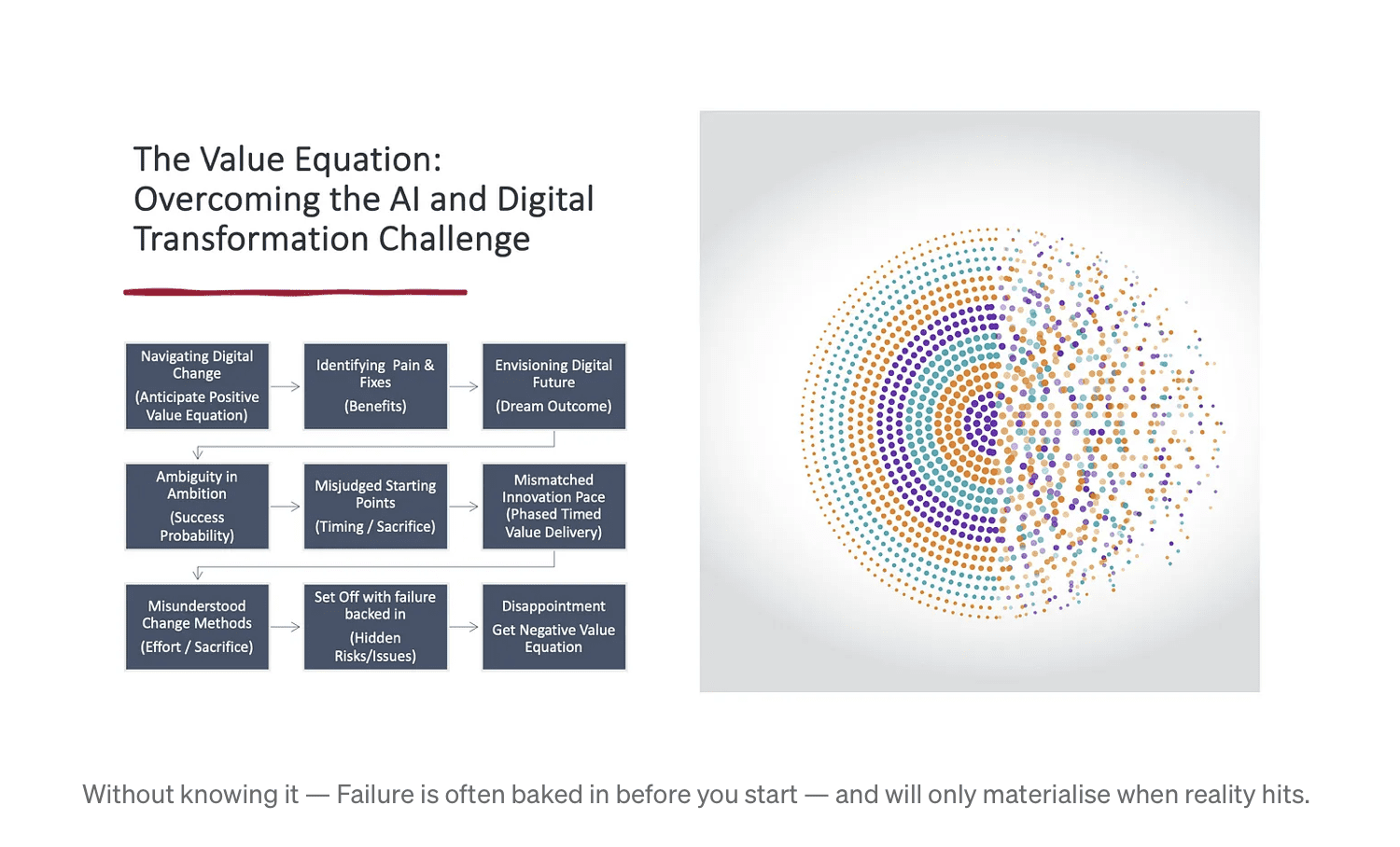
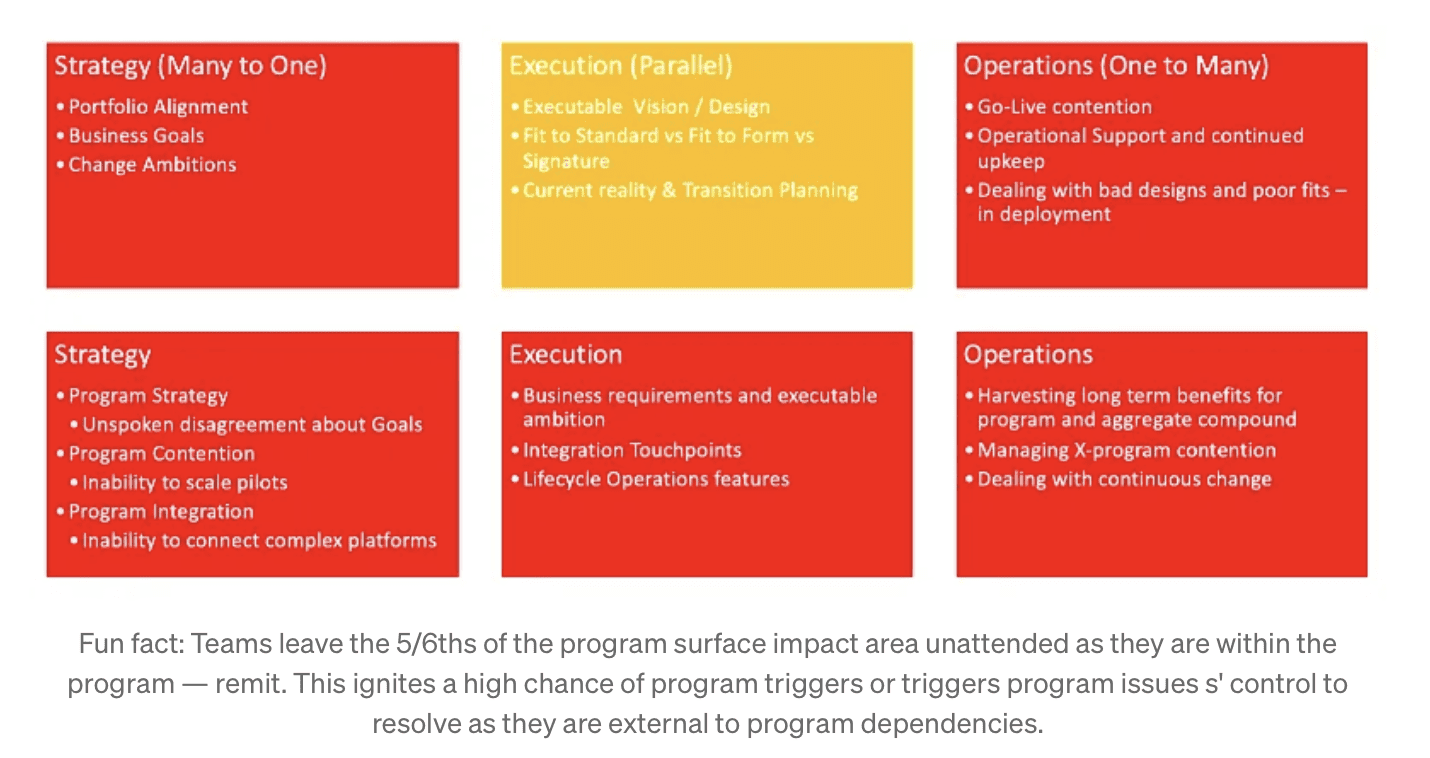

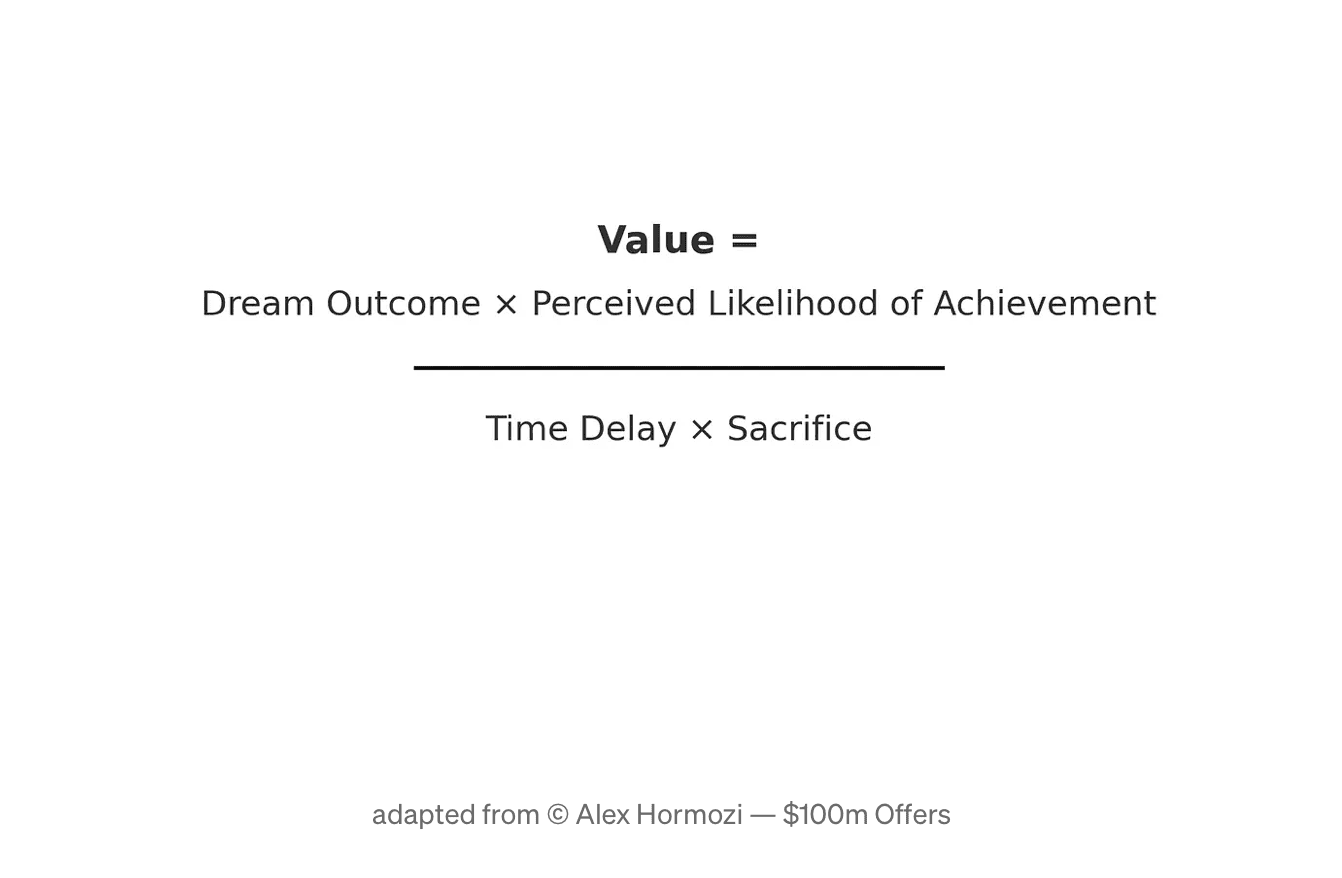

Imagine this: As accountable for your digital transformation program, you’re in the hot seat and feeling the pressure. But now, it’s about more than just digitizing processes or moving to the cloud. The stakes have never been higher with the rapid advancement of AI technologies. Your organization is looking to you to lead not just a digital transformation but an AI-powered revolution that will redefine how you operate, compete, and deliver Value. After you green-lit your initiative following a steady period of solid momentum, it’s all going wrong around the first critical delivery.
Pressure is building. The demanding Steering Group meetings are turning increasingly hostile. Blind-sided by a continuous flow of bad news, as if issues were stacked in the bank waiting — one day to the next, rumors, corridor whispers, massaged reports — who has the facts? You’re wasting precious Time you don’t have, massaging commitments while reaching deep to understand reality. You need a credible, workable fix to renegotiate stakeholder expectations one last Time. Defending, attacking, firefighting, pacifying, deteriorating relations, and burnout. Issues everywhere — change is not easy.
This stress level is not just normal tensioned project dynamics you experienced earlier in the process. Status is critical — but somehow, no matter what you do, the spotlight shines brighter with you on center stage. Everyone else is either stagehands or in the audience, cajoling or dejected. The director is noticeably absent. Full attention is on you and your core team of supporting cast — carrying all the weight. All the responsibility. All the accountability. You own all the issues, all the headaches, and absent glory. You struggle hard to free up delays, reset for success, get things moving, and stay on track.
Challenged — you are in a tight corner and have little flexibility. Time, budget, resources, commitment, goodwill, patience, you name it, all your currencies are draining to empty — fast. The runway to take off is getting shorter and shorter — the deadline is approaching fast, and yet the %$*t list is getting longer and longer. What can you do? Yet something must get done — in Time for the reset deadline and budget — this is non-negotiable.
In a moment of reflection, you wonder — how did this happen? How could this happen? How on earth did we end up here? On your checklist, everything was fine from the start. You had assurances, engaged an excellent external team with a solid reputation, and your internal team was confident, committed, and ready to go. You are doing everything expected, indeed more, but despite this, somehow you ended up here — again!
It’s clear. At the start, well aware of high failure rates, you did all you could to be in the winner’s camp. Other reported failures didn’t know what you knew. But now — you’re aware. You’re missing something very critical yet elusive, but what?
Now, imagine a different scenario where you introduce a success component that first changes the mindset, builds understanding, and develops a capability, given the same start conditions. Could this be enough to shift the odds from failure to success?
Can an understanding and application of the Value Equation be applied to this scenario to change the Outcome for our challenged team and sponsor? More importantly — can it help you avert a similar outcome?
Let’s see.
Introducing The Digital Native Value Equation.
Full disclosure — I found this Equation a couple of years ago while researching what makes digital natives successful. I’ve applied it to a new digital transformation framework that my colleagues and I are developing to help traditional enterprises achieve Value from digital transformation initiatives.
Problem: Enterprise Value is Lost or Destroyed In Technology Translation
As stated in the intro, this too-familiar situation and the increased importance of digitalization underpinning every aspect of Business suggest a pressing need for a new approach to tackling digital transformation initiatives.
Consider how quickly digital natives in the Web 2 era have developed business technology at an exponential rate, setting a high floor on consumer and business expectations. Now, add the complexity of AI into this mix. This step-up is critical for establishing new business models, ecosystems, platforms, and customer experience capabilities. Business technology, particularly AI, is an increasingly powerful driving force.
The message is clear. Traditional enterprises with established processes, cultures, and competencies must rapidly innovate WHY, WHAT, WHO, and HOW to remain competitive. And now, they must do so while navigating the complexities of AI integration. This task requires not just technological prowess but a fundamental rethinking of how Value is created and delivered.
As I write this, we are entering what some economists, like Raul Pal, call the “economic singularity.” The economic singularity is a point, potentially within the next 5 to 10 years, where standard economic models we’ve relied on to project GDP growth — based on productivity growth, debt growth, and population growth — are being fundamentally challenged.
We’re witnessing a perfect storm of economic forces: declining demographics in many developed nations, seemingly unsustainable debt burdens, currency debasements, and unprecedented productivity gains driven by digitalization and AI. These factors combine to create an economic landscape that defies traditional predictions and is already allowing us to stave off what should, by all historical measures, be a post-COVID global recession.
In this new paradigm, we may project a massive shake-out. As in past technological revolutions, organizations that are weaker, slower, or failing to adapt will likely disappear. The window for bold action is narrowing, and for many, it may close before they even realize the urgency of their situation.
What are you doing? How are you doing it? How well is it going?
The stakes have never been higher. It’s about more than successful digital transformation to capture growth opportunities and marginal savings. For many organizations, it’s now about change for survival — building the fittest, most adaptable version of themselves.
In this context, AI isn’t just another tool in the digital transformation toolkit. It’s becoming the defining factor in organizational fitness.
Those who can effectively harness AI to augment human intelligence, automate processes, and drive unprecedented productivity gains will be the ones who not only survive but thrive in this new economic reality.
However, this AI-driven transformation is complex and fraught with pitfalls. It requires not just technological expertise but a fundamental rethinking of business models, organizational structures, and even the nature of work itself. This impact is where understanding and applying the Value Equation becomes not just helpful but essential for survival and success in the age of the economic singularity.
In other words, our ambitions are no longer just about successful digital transformation to capture growth opportunities and marginal savings. In many cases beyond this, it’s now about change for survival — building the digitally fittest organization and team to sustain us into a future we own.
What makes fitness? Can fitness be a state of mind before it’s a reality? Is there an element of faking it before you make it? Being an adaptive enterprise, is this a culture, a constant state of being and acting and evolving — rather than a declaration at the end of a journey — and if so, HOW so?
These are essential questions for every Business engaged in digital transformation. Efforts to drive new growth, profitability, and sustainability are mandated intentions — but how is this new state secured?
The problem is that change is a challenging, time-consuming, constantly advancing process. You need the necessary Awareness to explain, understand, and then continually simplify and evolve your change procedure to guarantee and speed up sustainable results.
Many transformation initiative attempts fall short because they fail to recognize the actual problem or lack an integrated system that links all the change elements into a clear, transparent path.
As a result, Value, so to speak, if it ever existed, is inadvertently destroyed or indeed lost in translation.
Adaptive Leaders Value Equation: Simplicity is Power — Start A New Way Forwards
Could a simple Value equation help you address the underlying cause of all your digital transformation challenges? Build your Awareness, knowledge, understanding, and capability to detect the most overlooked potential traps that frustrate your progress and outcomes.
In short — give you control?
Let’s briefly explore the Value Equation:
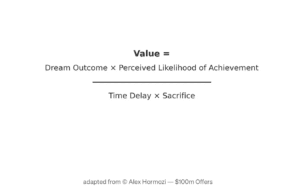
AI Value Capture
Let’s keep it simple and illustrate with some examples to help you grasp the spirit of the value equation and how it will apply to you.
First, we’ll define the components and then explore how to look at your project through the perspective of the value equation lens.
- We will explore how the Value Equation can reveal hidden issues. Lastly, we’ll understand how you may apply this to any digital transformation initiatives to put you in a solid value setting as an adaptive leader.
Components:
Dream Outcome: Your ambition, target, and expectation. In the age of AI, your dream outcome might include improved efficiency, growth, and profitability and AI-driven insights that transform decision-making, predictive capabilities that reshape your business model, or AI-powered customer experiences that set you apart in the market. I recommend this expressed as an end state and outcomes. Your Dream Outcome can comprise real numbers, direct, indirect, tangible, intangible Value, etc.
Perceived likelihood of achievement: Your probability of success, a high percentage, expressed in terms of mitigated risks, active success measures, and countermeasures for risk avoidance.
Time delay: The latency between Opportunity inception and Operationally embedded — your timeline by which you must start harvesting benefits against your outcomes.
Effort and Sacrifice: What you must do to achieve Your Dream Outcome — expressed by effort days, resources — financial, non-financial, critical, etc., and sacrifices, impacts required, etc.
Value: The ratio of output over input — should, by definition, be a positive number.
These definitions are self-explanatory. Let’s examine the structure of the Equation using the hypothetical situation in the introduction.
Value Equation Structure:
The numerator is about the Outcome and ambition, and the denominator is about what it takes to get there.
Note: The goal is always to make the numerator larger and decrease the size of the denominator. We will use a working example to show how important this fact is.
Value Equation: Digital Transformation Initiative — Worked example an illustration to make it easy to model your scenarios.
Scenario — Replacement consolidations, budgeting, and forecasting system
The expectation is a timely replacement of a consolidations, budgeting, and forecasting system. This change initiative is considered a tactical lift-and-shift scenario, a simple job supporting organizational Finance and Business transformation. The PID and Business Case are available, and the Executive team has Green-Lit the initiative.
The Dream Outcome — The business case: This is effectively a bold trajectory, a true north statement, almost certainly tempered with hard commitments in the business case. Every business and sponsor, green lighting program, will have this base covered, and it will be a sufficiently high projection-based Benefits and ROI business case.
Example Dream outcome: Benefits are improved speed and accuracy of the financial close, faster, more accurate planning cycles, improved profitability and variance reporting, and better strategic decision support. We would harvest savings from reduced resource effort by doing manual reconciliation, retiring the old legacy system, simplifying the system landscape, and shifting to a cloud-based subscription model. It will support the Finance transformation and, in turn, the business transformation.
Needs + Benfits / Investment = Positive RoI = Green : Go
So far, so good.
Perceived Likelihood of Achievement: the PID (Program initiation document) — The risk mitigation section discusses QA, Governance, and the myriad of Risks, Issues, Assumptions, Constraints, and Dependencies and their respective mitigations. It also includes positive countermeasures to increase success, such as buying brand software and reputable SI, and risk avoidance countermeasures, like solid commercials. The Perceived likelihood of achievement is, by definition, HIGH at the outset.
Example Perceived Likelihood of Achievement: The risk assessment factors all the usual suspects — assumptions defining the scope boundaries, resources, approach, Data, legacy systems, choice of solution vendor and SI to minimize risk, and so on. Addressable assumptions, risks, constraints, and dependencies are all identified and factored in. The team will address uncertainty with the agile delivery approach and governance to assume a close to 100% confidence factor.
Likelihood of success >95% = Green: Go
So far, so good.
Time Delay: The PID and Program Plan at various levels of detail at the outset, from the plan on a page factoring the roles, appropriate dependencies, high-level budgets, contingencies, time driver assumptions, etc.
Example Time Delay: The plan on a page projects a 12-month delivery cycle end to end, with a parallel running process taking another quarter. The plan considers input and expert judgment from the appointed delivery partner from a technical, functional, and experience approach perspective and the decision from business leaders and internal teams and from the respective functions to allow for business commitments, dependencies, and contingencies.
Acceptable Time Projection = Green: Go
So far, so good
Effort and Sacrifice: This includes the PID, Program Plan, Change Plan — Critical role staffing necessary to perform your undertaking, resource mix, capability building strategy, outsourcing offloading strategy, etc.
Example Effort and Time Sacrifice: Following consultation with the delivery partner, the Business and technical teams are satisfied they can commit to the resourcing mix and capability expectations projected in the plan. They have identified and mitigated all known risks that could delay delivery due to other business constraints and priorities.
Acceptable Effort and Time Sacrifice = Green: Go
Now WHAT- So WHAT?
As you can see, the value equation covers every digital initiative you are already undertaking. OK, I hear you ask, so what? Everything is green. So far, this Equation has done nothing new for us beyond what we already have and know.
As per the opening situation, we would go ahead with all the greens, even ambers, and we would still be in this mess — and we would be no better off than otherwise!
Here’s the punchline: The reason the Program above is failing is all about driven behaviors and Optimism Bias.
The power of the Value equation is in the interdependencies! Your business case, PID, and supporting documents hide this, as they did above, making it too easy to overlook.
Behavioral Analysis in Program Business Case and PID Fitting:
Let’s take another look at the Value Equation.
Worked example: The team naturally focuses on getting the Program started and done.
They conduct a thorough Discovery phase, selecting vendors and system integrators before the Board approves the business case (Dream Outcome) and PID (High likelihood of achievement). Everyone agrees on clear specifications. This foundation (numerator) drives extensive negotiations to create a “realistic plan” and “realistic budget” backed by “realistic robust commercials” (denominator). The team sees four positive indicators and believes everything is in good shape.
Everyone celebrates as negotiations conclude.
However, they’ve unwittingly set the program switch to failure — a fact that escapes everyone’s attention. Why? They’ve inadvertently prioritized minimizing the denominator (time, effort, resources) at the expense of the numerator (dream outcome, likelihood of success).
This imbalance, hidden beneath the veneer of a “good deal,” sets the stage for future challenges and potential failure.
What went wrong?
Once we have anchored the dream outcome and likelihood of success, we naturally set to work on the denominator, as we see in the example. We have a natural bias, pressure, and dynamic from every dimension and actor possible to reduce the time delay and effort while minimizing Sacrifice.
As we minimize Sacrifice, the active driver that gets “negotiated” away is Time Delay.
The multi-party bias to get going and get done while overlooking proper accountability by transferring risk commercially to third parties, with actual risk amplified by aggressive procurement practices — drives this failure outcome. (NB this is not a call for writing blank checks and not negotiating — I’m simply highlighting a hidden risk for mitigation)
Let’s dig in: You likely expose your Program to these tendencies. Consider these three natural biases on Time delay and how they may apply to you.
1) Direct Time behaviors that drive Time Delay
- Let’s get it done asap
- Let’s get started asap
- Let’s reduce budgeted costs via timeline and activity compression.
2) Direct Effort & Sacrifice behaviors that drive Time Delay
- Let’s minimize the impact to / we don’t have key business resources
- Let’s reduce costs via an optimized resource mix
- Let’s narrow down our ambition and scope to fit timelines and budgets.
- It’s relatively easy for third parties to downplay complexity and effort to get to outcomes
- Third parties downplay the current reality inputting to start point factors
- It’s relatively easy to concede effort and resource demands in challenging procurement demands
Impact: Getting started ASAP and inadvertently reducing these drivers for the execution phase puts all the attention on getting the Program right and inadvertently locking in the inherent risk factors we discuss in the next section.
Worked Example: During the negotiations, there were extensive discussions about the SI’s plan being too padded — and the competitor’s plans were way more comparable to expectations and budgets.
- There were further negotiations to first add on more client-side resourcing to reduce the external staffing cost, rebalance the staffing pyramid, then, with an acceptable agreement to second more backfill resources to free up business capacity, push back to SI, and leave some key slots unfilled at the start.
- Timelines, the scope, business change, and training are analyzed in depth, as are data quality and systems integrations.
- The SI committed commercially to getting the job started and done against a design-build-run scenario, considering ongoing support, with assumptions and conditions placed on the Client around ownership, deliverables, and roles.
- The Client, with a strong program focus, accepted the deal inputs, and then final price negotiations on rates and effort are secured and locked in.
This approach is all normal behavior and accepted practice.
Impact: The Client perceives they got a good deal — and by some measures, they have. As with every negotiated deal, it’s a clear win-win, so to speak.
- However, the Vendor and SI know they now carry minimal execution risk and accountability — even in a fixed-price scenario. In all probability, events are near certain and guaranteed to trigger on the Client’s side following an extraneous business event or extensive pressure build-up on client-side issues over an extended painful period will warrant a reset.
These negotiated time-delay factors are triggered in our intro scenario, but is this enough to cause actual delay and disaster? We’re not quite done yet.
This program-centric denominator optimization on Time delay/effort cost reduction is the catalyst for a much bigger chain of events, ultimately destroying enterprise value.
-----
Briefly — this is the chain of events triggered by everyday commercial practices and behaviors:
Natural Bias 1: Focus on the Program and not surrounding Factors
We have seen above that optimizing the Program can expose you to extrinsic program factors, which have many triggers.
Optimizing the program event: Your Focus is incomplete:
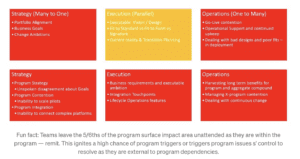
YOU cannot win by controlling 16% of factors - why 85% fail.
Sobering fact: Teams leave the 5/6ths of the program surface impact area unattended as they are within the program — remit. This ignites a high chance of program triggers or triggers program issues s' control to resolve as they are external to program dependencies.
This 5/6th coincides with the 90 failure rate — coincidence?
Natural Bias 2: Ignoring/isolating hidden YOU Factors
YOU Factors are all the things YOU as the client must do in order to succeed with digital transformation, AI or any other initiative. These factors are always overlooked and are the source of most contention.
- Strategic Change Portfolio contention-e.g business and digital transformation
- Strategic Program dependencies — Operating model changes, connected systems and architecture, and change approach
- Operations and Embedding change contention issues

AI Generated YOU Factors for YOUR Programme
Illustration — Tailored YOU Factor Necessary Conditions — for a typical enterprise-scale digital transformation — Columns = Accountability / Rows = Lifecycle © Author eFinity > 160 discrete data points YOU must manage to control the lifecycle successfully.
Impact: Getting started ASAP with ramp-up to execution, as we said, while intuitively this makes sense, puts all the attention on getting the Program right and overlooks the critical upstream and downstream necessary conditions required to get the job done.
- For instance, very early on, during the design phase, many questions will be asked, pushed to the program execution phase, and required to map your Business onto the software.
- Besides the direct detailed requirements and assumptions, organizations delivering complex platform solutions often need to pay more attention to the changing context of the Business, the business goals and ambition, and other substantial revenue and cost priorities. All these factors influence the solution design.
For instance, in the worked example, there were, in fact, at least three different solutions — treated as separate, with solid dependencies on the same future state value and target operating models.
- This understanding is completely missing. The FP&A solution, connecting to the Consolidation Solution, connecting the BI solution, which was not even in scope, connecting to the disparate ERP transaction engines, also earmarked for replacement — all forming a stated ambition to support the Finance Transformation, with no vision from this programs view on Finance, and in turn, the Business Transformation that was happening on market pressures demanding a restructure.
How is it possible to replace any systems in a unified way in this backdrop. Each business lead of these systems and process owners was left asking the same questions from the SI teams that started immediately into the design.
We have high-level requirements, but what is the business design? Each component needs a different interpretation of the business transformation requirements, but each needs to form a connected part of the complete solution to meet the overall transformation ambition. When detailing requirements, source systems, business dynamics, finance transformation, and business transformation are overlooked. Assumptions are made in Discovery that the modern fit-to-standard approach is applied. When the teams came to design and implement the Fit to Standard scenarios, it became clear that the valid business requirements to support the system design build and delivery were missing.
Referencing the Value Equation — The consequences were that the desired Outcome based on stated assumptions was at risk, the assumptions around the perceived likelihood of achievement were suddenly reduced to less than 50% — Red, with the SI billing against budget, and effectively delayed from working on value-added critical path activities, across all three projects, additional business resources functional and technical resources were required to address the detailed operating model transformations.
In the process, functional and technical compromises are made in the spirit of agile principles to keep pressing forward and accommodate change later. No considerations are made to the context of change or suitability of operational fit.
Downstream in testing — these assumptions would be tested — as the business and finance transformation takes hold. The Dream outcome is invalidated, the probability of success by these measures is lower, not higher, the Effort and Sacrifice are exploding, and the time delay is expanding. The scenario is out of control in a virtuous circle of stress, tension, and decay.
Picture: The denominator is expanding, the numerator is shrinking, and Value is not only not being realized from the Program — this is still just WIP — but it risks destroying current or future Finance and business value from the transformation if it were forced into a go-live scenario. This is the connected nature of change.
Natural Bias 3: Unwittingly then deliberately disconnecting change drivers from Value Outcomes
- Unsynchronized Business Technology and Change cycles (vs product and lifecycle)
- Program-centric, Event-driven (vs. Complete End to End lifecycle view)
- Point Solution Centric (vs Platform centric)
Natural Bias 4: Overestimating AI and Digital Capabilities and Underestimating Integration Challenges
- Assuming AI is a plug-and-play solution that will immediately solve all problems
- Underestimating the data quality and quantity required for effective AI implementation
- Overlooking the need for human expertise in interpreting and applying AI insights
These factors directly suggest that one overestimates the dream outcome and underestimates Time, effort, and Sacrifice.
The Crisis Reaction
If all this were not bad enough, the final act of reputational rescue is all but guaranteed to kill the Program and, if not, the downstream Finance and Business transformation.
To get something done — to save the face and reputation of all the Actors — the narrowest, least amount of Value is defined. This remediation ignores Business, technology, and change cycles. It ignores upstream and downstream factors surrounding the Program that are required to secure sustainable program outcomes. The intervention becomes, by definition, a very narrow, isolated, minimized point solution with the smallest operational footprint to mitigate the go-live business impact.
Success is declared, but both short and long-term Enterprise Value is destroyed. The Fate of >80% of Digital Transformations.
Regarding the Value Equation, the teams had to collude on the minimum that could be done to assert a win by some very loose measure of success. This became the focus. In a cross-team, cross-program huddle, the negotiations started. The revised plan was presented and agreed upon. Original Value, budgets, time delay, and Sacrifice were all completely ignored to deliver a pseudo-value to enable an exit strategy.
Nobody, after all, wants a reputational failure — at almost any price. In the final analysis, a pseudo-value is delivered — for reputational purposes. The perceived chance of success is kept workable by diminishing the Outcome and maximizing the denominator. The Time-delay is massively extended, and the effort and Sacrifice are off the charts.
Let’s summarize this before we proceed:
- We had a strong business case, and PID and everybody agreed to proceed. It was green to go.
- Because we had constrained resources on the client side and no time and money to waste, we wanted to get started ASAP. We had a natural program bias to get started and get done.
- We actively negotiated away the time drivers — reducing effort on both the Client and SI sides — to achieve our desired Outcome on paper. The plan looked promising. However, as soon as we began, our natural program bias exposed the flaws in our paper assumptions underpinning program success.
- First, we overlooked detailed requirements for the business design. This oversight forced our heavily negotiated resources to sacrifice Value against stakeholder expectations as they scrambled to mitigate the unforeseen requirements. A cascading chain of events unfolded, with time delays increasing to compensate for the unexpected workload.
- We then discovered numerous surrounding factors (YOU Factors) on the client side that we had failed to address — critical path factors on business requirements that now required significant additional effort to resolve. Our teams continued to work on non-value-added, non-critical path activities while the Client borrowed critical resources from other projects to tackle the minimal missing work. This reallocation of scarce resources triggered compounding Time and cost pressures across our project portfolio.
- Ultimately, we found ourselves unable to deliver anything of Value. Despite the teams’ efforts, they had nothingsubstantial to show for their effort and cost.
This Outcome starkly illustrates how our initial focus on the Program minimizing the denominator (time, effort, resources) severely compromised our ability to deliver on the numerator (our dream outcome and completely diminished our likelihood of success).
None of these interdependencies played out because the Client needed to have the Value Equation at hand.
- They had a business case (put in the bottom drawer),
a PID (with many assumptions) - A poorly negotiated plan because, in effect, the Client was taking all the hidden risk.
- The SI and Vendors could deliver only if the Business were enabled to do so. The SI and Vendors got paid the first time anyway, and again a second time to get the job done correctly once the Business was finally prepared.
Part 2: Applying the Value Equation to Your Case
Your problem — Succeed with Digital Transformation — AI and other initiatives while facing rapid disruptive change:

The Slippery Slope to Failure is Baked in
Pic: Without knowing it — Failure is often baked in before you start — and will only materialise when reality hits.
Now imagine this — Leveraging the Value Equation Principles for success:
You arm yourself with the Value Equation and constituent success factors driving the elements of Value. Use these as powerful tools to secure your success.
“The Value Equation helps me maximize and accelerate value creation through value-centric initiative portfolios, driving exponential growth and innovation.”
The result you will achieve after completing this step is:
A dynamically optimized portfolio of high-impact AI initiatives maximizing growth, transformation, and sustainability value
Incorporating Value Equation Principles:
Dream Outcome (DO):
Example: Emphasize the potential for exponential value creation through AI and showcase how AI can amplify each initiative’s impact.
Action: Analyse Your Business Case Outcomes and quantify value. Note the phasing of the value — as a lot of value vests over time.
Note: There is no value creation until the technology is operational in a minimal form and will compound with further features and deployments. Quantify the value in phases starting from first go-live.
Perceived Likelihood (PL):
AI Example:
Use AI-driven predictive analytics to increase confidence in outcomes
Demonstrate clear linkages between AI initiatives and value metrics
Action: Analyse Your Business Case RAID log / Assumptions.
Score Probability High=1.0, Medium=0.5 Low=0.1
Time Delay (TD):
AI Example:
Highlight AI’s ability to accelerate Value realization
Show how AI can reduce time-to-market for innovations
Action: What is the duration to your first tangible benefit — defined as the first go-live and then future timing of benefit expectations with later deployments.
Note: This is the time to value starting from the first operational go-live, compounded into the future often over several years.
Effort and Sacrifice (ES):
AI Example:
Illustrate how AI optimizes resource allocation
Demonstrate reduced effort through AI-driven automation and decision support.
Action: What is your direct cost estimate to first go-live and then subsequent go-lives and adoption cycles. (SEE YOU example above)
Note: The cost to get to the first go-live may be more than the return — but this should be mitigated with intangible benefits like investing in foundational capabilities that can be leveraged in later waves.
Anchor your dream outcome firmly. Qualify it with detailed requirements and analysis to challenge assumptions and secure that Outcome from YOUR perspective.
How does your value equation look: is it positive — the Value ratio should always greater than 1.
The key is to link your release/waves with time to complete the denominator and match that with benefits.
Scenario plan using the Value Equation Variables:
Reducing the probablility reduces the Outcome — increasing the effort to reduce the time keeps the denominator high.
---
Now, follow these steps:
- Take an end-to-end view of the Program within the context of overall change. Ask yourself:
- How can you break this into smaller highver value increments and deliver them quickly and continuously.
- What do you need from upstream to deliver a working solution in operations?
- Adopt a lifecycle-changing capability evolving product platform view instead of a classic program and change event view.
- Design early iterations of Value, building them into your Dream outcome.
- This approach reduces the time delay to priority impact.
- Ask yourself: What is the smallest, fastest amount to deliver now and then incrementally — while building a platform/product — to add incremental compounding value in later releases? (vs monolithic program deployments).
- Deliver priority value faster.
- Watch as your Value Equation ratio and probability success factors remain high and go higher as you continuously improve. Ask yourself: What constraints are in my line of sight to go-live and embedded operations?
- How can I capture value fastest and how can I keep delivering ongoing compounding value as the market and experiences change.
- Focus on the critical events needed to secure the Outcome:
- During negotiations, resist the urge to simply cut resources or adjust scope and time to meet desired budgets. Instead, perform robust cross-checks.
- Identify your constraints and critical success factors.
- Project beyond the Program. Integrate components into a more holistic platform product view.
- Plan for future iterations. This foresight allows you to make strategic hires, securing ongoing capabilities.
- Engage your SI as a true partner.
- Enable them to support your transition and capability building.
- Allow your partners to provide more robust value-added capabilities at the front end and back end of the business transformation over a longer duration, delivering, instead of a monolithic program, a faster, more sustainable changing capability outcome that delivers rapid compounding value and endures over multiple faster, smaller program iterations vs a monolithic change event.
This approach beats trying to maximize everything from a single Program event.
Watch as the world transforms into a much better place from this viewpoint!
Conclusion: Mastering Digital Transformation in the Age of AI
As we navigate the complexities of the digital age and the impending economic singularity, the stakes for successful digital transformation have never been higher. The Value Equation we’ve explored isn’t just a theoretical concept — it’s a powerful tool that can very simply set your mindset and understanding to focus on the factors that matter — and spell the difference between transformation success and failure.
Let’s recap the key insights:
- Traditional approaches to digital initiatives often lead to value destruction, not creation.
- The Value Equation helps expose hidden biases and interdependencies that typical program management overlooks.
- By focusing on maximizing the numerator (Dream Outcome and Perceived Likelihood) while optimizing the denominator (Time Delay and Effort/Sacrifice), organizations can dramatically improve their transformation outcomes.
- AI isn’t just another tool — it’s becoming the defining factor in organizational fitness and survival.
As leaders, we must shift our mindset from event-driven programs to building enduring, adaptive capabilities. This means:
- Taking an end-to-end view of transformation initiatives
- Adopting a lifecycle-changing capability approach
- Delivering priority value faster through incremental, compounding improvements
- Engaging partners in long-term value creation, not just short-term project delivery
The Value Equation provides a framework to achieve this shift, helping you navigate the complexities of AI-driven transformations where the potential for both value creation and destruction is amplified.
Ask yourself this — Are you ready to transform the way you transform? It’s time to leverage AI not just as a tool, but as a means to adopt AI and drive digital transformation.
Don’t let your organization become another transformation failure statistic. Take the first step towards true transformation today. Explore how the BusinessGPS.ai Ascend method, powered by the Opportunity to Operations (O2O) process, can help you navigate the complexities of digital and AI transformation.
Remember, in the face of the economic singularity, it’s not just about successful digital transformation — it’s about organizational survival and thriving in a rapidly changing world. The future belongs to those who can effectively harness AI to augment human intelligence, automate processes, and drive unprecedented productivity gains.
Are you ready to secure your organization’s place in that future? Let’s embark on this journey together.
Next Blogs
In the next few blogs, I will introduce you to the AI assistants and frameworks you can use to maximize the Value Equation principles by leveraging AI.

BusinessGPS.AI Ascend approach to AI Adoption
BusinessGPS.ai Ascend: The Value Equation Lies at the Center of Digital Transformation
Modern Business Transformation is where the Opportunity to Operations (O2O) process, powered by BusinessGPS.ai Ascend, comes into play. This AI-driven system is designed to guide you through every step of your digital and AI transformation journey, directly addressing the challenges highlighted by the Value Equation.
By leveraging AI to adopt AI and drive digital transformation, BusinessGPS.ai Ascend offers a unique approach to maximizing Value and minimizing risks. It provides real-time insights, predictive analytics, and adaptive planning capabilities that evolve with your transformation journey.
About TechShifts
The O2O (Opportunity 2 Operations) standard operating procedure is our industrialised technology adoption model and our trademark approach for reimagining our clients' digital transformation experience, combining data, technology, and AI to create positive experiences that cultivate your outlook, mindset, and capabilities to address modern technology driven Change sustainably…. We curate encounters utilizing data, technology, and AI that favorably influence your attitude toward Change while also encouraging you to be able to adapt successfully.


